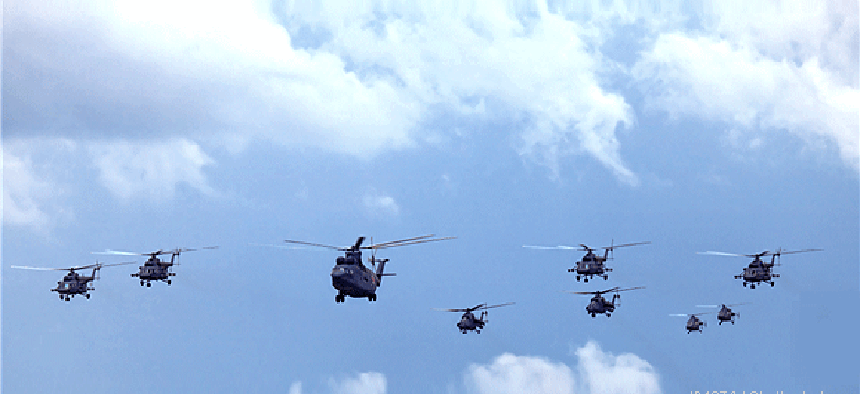DARPA takes multipronged approach to securing military's cloud


Connecting state and local government leaders
As DOD moves into cloud computing, pilots and projects look to assess risk and develop multiple layers of network defense.
Security is paramount because, in the cloud or not, the military’s networks are constantly being probed for weaknesses. In 2010 Army Gen. Keith Alexander, NSA director and commander of the U.S. Cyber Command, publicly said that about 250,000 probes try to find their way into the DOD network every hour, totaling more than 6 million attempts a day http://csis.org/event/cybersecurity-discussion-general-keith-b-alexander-director-national-security-agency. A range of other numbers were floated around that time, reported Forbes, http://www.forbes.com/sites/firewall/2010/06/04/just-how-big-is-the-cyber-threat-to-dod/ although all agreed that the number of attacks are increasing exponentially, with many being state-sponsored attacks from China.
Carey cited the intelligence community’s data security methods as a model for the DOD, although he noted that the DOD needs to have heterogeneous data security and a different network structure.
The core of the Defense Department’s plans to reduce its 1,500 data centers to “a number far below that” is implementing a secure, coherent and consistent computer cloud network architecture, said DOD principal deputy chief information officer Robert J. Carey at a recent cloud computing panel discussion.
While saving money is one reason for these changes, securing data is the most important factor.
“The access, the cost — all those facets of the efficiency of cloud computing — if it isn’t secure enough, it will not serve us well,” Carey said, according to a DOD report.
The problems with securing cloud computing are many. Today the cloud is secure for only certain types of data, Carey said. The department also faces difficulties transitioning from its legacy systems in a cost-effective manner. And how to measure cloud security is in its infancy. “At the end of the day, the metrics of cloud security are, at best, nebulous,” he said.
Then there is the structure of the cloud itself. Centralizing data, while cost-effective and a boon to data sharing, can also create a single point of failure. Shared code means a virus can spread rapidly through the system, which is difficult in siloed computer systems with different legacy coding.
DOD is addressing security on several fronts, one of which is its Mission-oriented Resilient Clouds (MRC) initiative, announced in 2011. Spearheaded by the Defense Advanced Research Projects Agency (DARPA), MRC aims to develop resilient cloud services that would continue to operate and support military objectives despite being hit by a cyberattack.
DARPA has issued several grants to develop solutions, including one to the Massachusetts Institute of Technology and a second to Johns Hopkins University, Purdue University and the University of Virginia. MRC system design and development will run through the end of 2014, with integration and testing ending by 2015.
The program indicates a shift in the way DOD is approaching cloud security, Bryan Ward, cloud computing practice director at Serco, a military technical services provider, said in a Defense Systems report in 2011. Most traditional tools focus on the physical infrastructure.
DARPA aims to explore several means to developing MRC, including providing redundant hosts, correlating attack information from across the ensemble, and providing for diversity across the network. In essence, it’s taking the cloud’s networking capabilities and turning it into a security tool.
Each node would monitor its own applications as well as others, MRC program manager Howard Shrobe said in an AOL Defense report. One method is to have multiple nodes compute an answer, with any node deviating from the consensus answer considered suspect, he said.
Shrobe described the model as similar to a public health system’s immunization program, with reports of possible attacks collected and analyzed for trends and patterns such as an "epidemic" of a particular type of system failure, according to the article. At that point MRC's diagnostic and self-repair capabilities would kick in, isolating the problem to prevent multi-stage attacks and then automatically patching the vulnerability.
A second security method being studied is resource allocation to ensure maximum mission effectiveness. There may be several possible ways to achieve a mission’s goal, each requiring a unique set of resources. By developing a trust model, the DOD can measure the probability of a corruption to those resources, causing the mission to fail, Shrobe said.
MRC is intended to be a companion program to the Clean-slate design of Resilient, Adaptive, Secure Hosts (CRASH) effort that focuses on limiting the vulnerabilities within each host.
A third approach the DOD is using to ensure secure network systems is taking it one step at a time, with multiple pilot cloud programs.
“We’re moving at a very deliberate pace,” Carey said. “We have lots of [pilot programs] going on to evaluate these kinds of things and to make sure we understand . . . the pros, cons and risks of moving into the cloud space.”
One research and development initiative in the DOD budget request for Fiscal Year 2013 is a cloud solution to support information sharing and to bridge the performance capability gaps in the Pacific Command. A second is for using cloud services to facilitate command and control operations, reported Safegov, a forum for IT providers and industry experts trusted and responsible cloud computing solutions for the public sector.
MRC is one of the topics that will take center stage at IDGA’s upcoming Cloud Computing Summit , being held Feb. 25-27, 2013, in Alexandria, Va.
NEXT STORY: Small city breaks new ground as service provider




